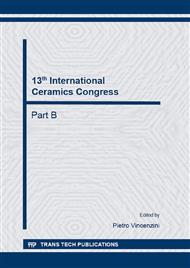p.15
p.21
p.31
p.37
p.43
p.49
p.54
p.60
p.65
Microwave Technique: An Innovated Method for Sintering β-Eucryptite Ceramic Materials
Abstract:
Microwave sintering has emerged in recent years as a new, fast, cheap and green technology for sintering a variety of materials. The main advantages of microwave heating can be summarized as follow: reduced processing times, energy costs and environmental benefits. Nevertheless, understanding how this specific heating drives to obtain ceramic materials with a combination of unique, structural and functional properties is the big challenge. The present work shows the different and improved properties achieved with β-eucryptite nanocomposite ceramic materials by microwave heating compared with the conventional method. Microcracking evolution in addition to the microstructure of the sintered materials along the several thermal cycles has been studied. Mechanical properties changes observed can be related to this process. Thus, the microwave technique is a promising tool for sintering new materials by controlling the composition of the phases, chemical reactivity and nanostructure, using up to 70% less energy in the whole sintering process than conventional heating. This technique becomes part of the new and innovative technologies "eco-green".
Info:
Periodical:
Pages:
43-48
Citation:
Online since:
October 2014
Price:
Сopyright:
© 2014 Trans Tech Publications Ltd. All Rights Reserved
Share:
Citation:


